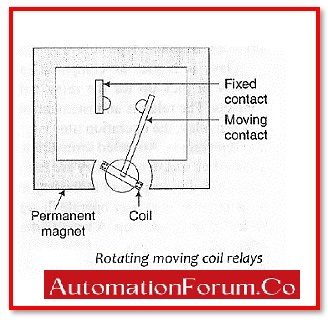What is Movable Coil Relay?
The most sensitive electromagnetic relay is the moving coil relay, often known as a polarised DC moving coil relay. This relay is frequently used for sensitive and accurate measurement for distance and differential protection due to its high sensitivity.
Relays of this type are by default suitable for DC systems. Although this sort of relay can also be utilised with an AC system, a rectifier circuit must be included in the current transformer.
What is the operation of a Movable Coil (electromagnetic type) Relay?
The electromagnet becomes magnetic when current is applied to the operational coil, and the armature is drawn toward the core. In turn, the usually closed (NC) contact is disconnected (turned OFF) and the normally open (NO) contact is connected (turned ON) by the moving contact.
Construction of Moving Coil Relay:
The components are:

- The permanent magnet
- A coil wound on non-magnetic – aluminium former
- An iron cores
- A phosphor bronze spiral spring to provide resetting torque
- Jewelled bearing and
- Spindle etc
The coil can move axially or rotary in a moving coil relay. While both have undergone extensive refinement at the hands of many designs, a moving coil relay’s basic limitation that it must direct current into and out of a moving coil system that must be extremely sensitiveremains in it.
Working of a Moving Coil Relay:
1. A flux is produced when a current is passed to a moving coil.
2. Because of the poles of permanent magnets, there is already a powerful magnetic field.
3. As a result, a force and a deflecting torque were produced to the moving coil, according to Td.
4. The polarity of the input supply impacts the deflection of a moving coil (permanent magnet) relay.
5. Aluminium former serves as a dampening effect.
6. Typical operation lasts two cycles.
7. The operational current is proportional to the coil current.
8. The torque applied to the spring is inversely related to its deflection.
9. Inverse operating time and current characteristics are obtained.
10. The interaction between the permanent magnet and the magnetic coil produces the operating torque.
Advantages of Moving coil Relay:
1. It has a consistent scale
2. A high level of sensitivity
3. It is quite accurate.
4. It uses less power.
5. Because of the strong magnet, the operating current is minimal.
Disadvantages of a Moving Coil Relay:
1. Only suitable for direct current measurements
2. The price is excessively high because of the accurate machining and delicate construction.
3. Friction caused by the jewel-pivot suspension
Types of Moving Coil Relay:
Two types of movable coil relays are available:
- Rotary- moving coil and
- Axially moving coil.
Rotary- Moving Coil Relay:
The rotary type uses common jewel bearings and DC instrument construction, and it is less expensive. VA burden is very small in rotary moving coil relay. Used as slave relay with bridge rectifier comparators.

Axially Moving Coil Relay:
Due to the single radial magnetic gap, the axial variety is twice as sensitive. For even shutting the contacts, the typical sensitivity is 1/2 mW. The coil has only axial movement.

Application of Moving Coil Relay:
- Since it provides accurate DC Measurement, it is applicable in all DC Systems
- It is used as differential protection in Substation and also as distance relay protection for DC-TO-DC transmission.






